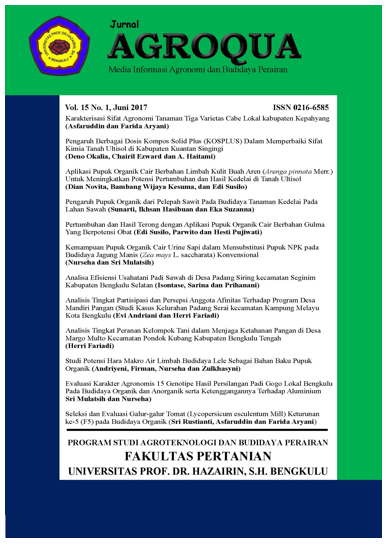RESPON VARIETAS KEMBANG KOL (Brassica Oleracea, L Var. Botrytis) DATARAN RENDAH DENGAN PEMBERIAN DOSIS PUPUK BOKHASI TANDAN KOSONG KELAPA SAWIT DI POLYBAG
DOI:
https://doi.org/10.32663/ja.v20i2.3024Keywords:
bokhasi EOPB, cauliflower, dose, varietyAbstract
The aim of the study was to determine the effect of the interaction between varieties with doses of bokashi EOPB on the growth and yield of cauliflower (Brassica Oleracea L). To determine the optimal dose of bokashi EOPB and to determine the varieties that are responsive in the lowlands. This research was carried out from February 2020 to April 2020, in Kungkai Baru village, Air Periukan sub-district, Seluma district, Bengkulu province, with an altitude of 100 meters above sea level. This study used a factorial completely randomized design (CRD) consisting of 2 factors, namely variety (V) and bokashi empty oil palm bunch (EOPB) dose (P) with 4 replications, a total of 72 experimental units. P1= EOPB bokhasi fertilizer 0 ton/ha. P2 = EOPB bokashi fertilizer 15 tons/ha, P3 = EOPB bokashi fertilizer 20 tons/ha. The variety factors was V1 = PM 126 variety and V2 = Ilona variety. The results of the study concluded that the interaction treatment between cauliflower varieties and the dose of bokhasi EOPB fertilizer gave a very significant effect on the variables of plant height at the observational ages of 5, 6, and 7 WAP and fresh fruit weight had a significant effect at harvest. The dose of bokashi fertilizer gave a very significant effect on the number of leaves and fruit diameter at the age of 7 WAP observations alone. The PM 126 variety is more responsive to cultivation in the lowlands by using a dose of 15 ton/ha of EOPB bokashi fertilizer.
Downloads
Published
Issue
Section
License
Authors who publish with this journal agree to the following terms:
- Authors grant the journal right of first publication with the work simultaneously licensed under a Creative Commons Attribution 4.0 Internasional (CC BY 4.0) Licence that allows others to use and share the work with an acknowledgment of the work's authorship and initial publication in this journal.
- The author(s) still hold the copyright of his/her/their work and retain publishing rights without restrictions such as (but not limited to) patent right, lecture, book and reproduce the article for own purposes.
















